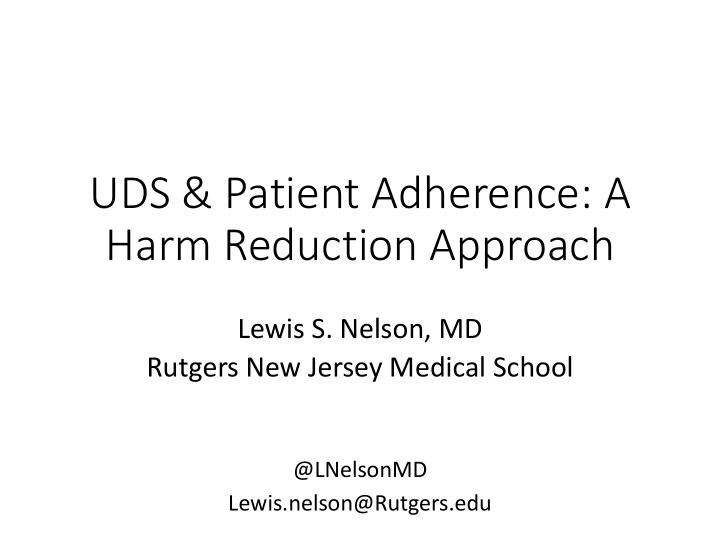



UDS & Patient Adherence: A Harm Reduction Approach Lewis S. Nelson, MD Rutgers New Jersey Medical School @LNelsonMD Lewis.nelson@Rutgers.edu
No Disclosures
Journal of Addiction Medicine, 2017
Inconsistent Test Results in Clinic • Testing is not meant to "catch" the patient • A positive finding suggests need to talk with patient • Review treatment plan • Not to prevent, limit, or change treatment
• Clinical Considerations in Drug Testing • Great utility in treatment of substance use disorders because denial is a feature of addiction • Testing identifies recent use it does NOT identify addiction or impairment • Language regarding the results of the test is important • Dirty/clean vs positive/negative
Screening and Confirmatory Tests Screening (Presumptive) Assays – indicate the Confirmatory (Definitive) Tests – specifically presumptive presence of drugs identify the drug detected in the screening assay Highly sensitive Highly specific Rapid, inexpensive Complicated, expensive Cutoff: Yes/No Quantitative
Screening and Confirmatory Tests • Screening assays: • This is all that is done in low-consequence situations • Done when confirmatory testing is not practical • Confirmatory testing: • Excludes analytical false positives and false negatives • Gas Chromatography/Mass Spectrometry • Liquid Chromatography/Tandem Mass Spectrometry (LC/MS/MS)
Analytical vs Clinical Interpretation • Analytical results • What the assay finds • Clinical results • What the patient used
Drugs of Abuse Screening NIDA/SAMHSA 5 Non-NIDA (Extended) • Opiates • Opiates • Amphetamines • Amphetamines • Cocaine • Cocaine • Marijuana • Marijuana • Phencyclidine • Phencyclidine • Barbiturates • Benzodiazepines • Methadone • Propoxyphene
Screening Tests for Drugs of Abuse • Enzyme immunoassay • Based on a substance’s structure • Relatively inexpensive, easily automated • Analytical false negatives are less common • Analytical false positives happen • Particularly for amphetamines, almost never for cocaine • Confirm positive screens…if the results matter
Case • A 30-year-old man presents to a treatment center. • Urine sent for toxicology assay. a. it returns positive for opioids b. it returns negative for opioids
Fentanyl Methadone
The “Opiate” Assay: Not So Good for “Opioids”
Case • A 21-year-old woman on buprenorphine presents to a treatment clinic. • UDS: +methadone • She states she does not use methadone False Positive (Analytical) Quetiapine Olanzapine Doxylamine Verapamil Diphenhydramine
Interpretation of a True Positive Opiate Screen (Analytical) • Clinical true positive (patient “misuses” an opioid) However: • Unclear which opioid • Cannot tell time of use or amount used • Does not correlate with effectiveness or impairment • Does not indicate route of administration • Clinical false positive (positive test, not “misusing” opioids)
Interpretation of a True Negative Opiate Screen (Analytical) • Patient is not using • Diversion of pain medicine • Collection/Lab error • Wrong assay used • e.g.: “Opiate” assay for oxycodone* • Cutoffs are often used* • Detection periods are short* (*clinical false negative)
Matrix considerations • Window of detection • Time to obtain results (availability of POCT) • Ease of collection (need for trained personnel, collection facilities) • Invasiveness/unpleasantness of collection • Availability of the sample (e.g., renal health, shy bladder, baldness, dry mouth) • Susceptibility of the sample to tampering
Drugs and metabolites are concentrated in urine Can compare to creatinine Drugs are found in much lower concentrations Easy to observe Drugs and metabolites incorporated into hair Concentrations of drugs low with sporadic use Prospective collection, 1-2 weeks Inter and intraindividual variability Invasive and expensive to test More direct relationship to impairment Easy to collect and observe Essentially limited to ethanol
ASAM Appropriate Use of Drug Testing in Clinical Addiction Medicine, 2017
Conceptual summary • Screening vs confirmatory • Testing results: • Analytical: what the assay finds • Clinical: what the patient used • What the results find are one thing • What you do with the results are another
We often have questions about choosing testing panels and proper interpretation of results. Where can I get help? • Medical or analytical toxicologist • Staff at a clinical or testing laboratory • A physician with MRO certification
Lewis.Nelson@Rutgers.edu
Recommend
More recommend